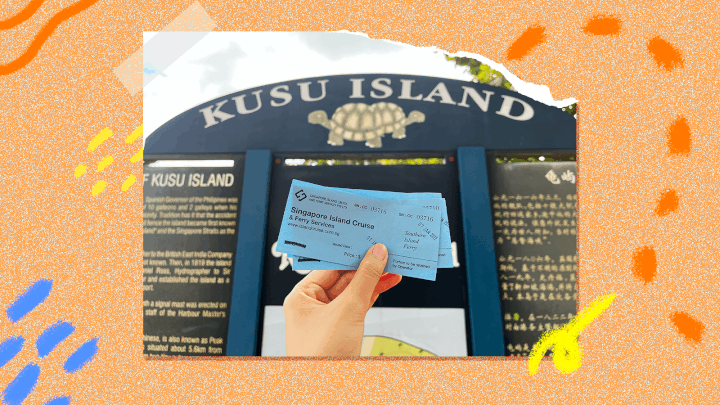Island Hopping: How To Plan a Passport-Free Island Getaway

Looking for a quick island getaway? A visit to Singapore’s Southern Islands is a great option to consider as you can enjoy enchanting sea views and island-hopping adventures all day long.
Booking Your Tickets
To book the tickets, buy your tickets directly at Marina South Ferry Terminal or pre-book online via Klook for the best prices.
Before booking, be sure to check the weather forecast and select an ideal day for island hopping. The ferries leave at various timings and the time of departure from Marina South Ferry Terminal will affect how your itinerary pans out.

Planning Your Itinerary
St John’s Island
For most trips, the first island you will visit is St John’s Island. Here, you can read about the island’s rich biodiversity and history from informative signboards placed at various locations. You can also participate in guided tours by the National Parks Board (on the first Sunday of every month) and be introduced to the key features of the island.
The western reefs on St John’s Island are part of Sister’s Island Marine Park, Singapore’s first marine park. To learn more about marine biodiversity and conservation, head to the Public Gallery at the Marine Park Outreach and Education Centre. Don’t forget to book your tickets online in advance.
After a brief trial in 2021 with a pop-up kiosk, a bicycle rental kiosk will be soon launched. This is a collaboration between Sentosa Development Corporation and Singapore Land Authority, which manages these islands.
The kiosk will be available about 400m away from St John's Island jetty. Visitors can cycle on rental bikes instead of bringing their own to explore the land-linked cluster of the Southern Islands.
This is the only island with public restrooms, so be sure to make a stop here before you proceed.
Lazarus Island
From St John’s Island, you can walk or cycle over to Lazarus Island via a strip of land that connects the two islands. This “causeway” has a picturesque backdrop of the aquamarine seascape, so whip out your camera and snap photos.
On Lazarus Island, proceed to the lagoon where you can find picnic spots. However, watch out for hungry monkeys and tuck your food away if you are not planning to eat immediately. If monkeys do approach you, stay calm – avoid eye contact and move away slowly.
(Read more about what to do during encounters with wild animals.)
After the picnic, make your way back to the jetty at St John’s Island to board the ferry to Kusu Island. If you wish to return directly to Marina South Ferry Terminal, the same ferry brings you all the way back there if you skip the stop at Kusu Island.
Kusu Island
At Kusu Island, you can read signboards detailing the legends and myths of the island. Every year, hundreds of devotees travel to the island’s Chinese temple and Malay keramat (shrine) for worship.
Due to the cultural significance of this event, the National Heritage Board has included the pilgrimage to Kusu Island into Singapore’s submission of UNESCO’s Representative List of Intangible Cultural Heritage.
Since Kusu Island means Tortoise Island in Chinese, you can expect to find a Tortoise Sanctuary containing hundreds of tortoises, with more housed in the temple. A visit to Kusu Island will not be complete without posing with the statue of giant tortoises that symbolise longevity.

Packing Your Barang-barang
Food
It is essential to prepare your own picnic as you won’t be able to buy food on the islands. Additionally, do bring along drinks to stay hydrated throughout the trip.
You can do some last-minute shopping at the Marina South Ferry Terminal’s convenience stores.
Remember to bring along plastic bags to store your trash and avoid littering to protect the island’s natural habitat.
Entertainment
On the islands, internet connection can be spotty. If you have music or podcasts you wish to access, it’s best to have them downloaded on your mobile devices.
Otherwise, how about taking a digital hiatus? An island-hopping trip is a good opportunity for a device-free day. Enjoy reading a good book or strum on a ukulele with loved ones. Or take inspiration from the flora and fauna on the islands and hold a live art jamming session.
Protection
As the islands are mostly unsheltered, having umbrellas and or even tents are useful for shielding yourself from the sun’s rays. Pack sunblock to re-apply on exposed areas of skin to avoid being sunburned.
Avoid pesky mosquitoes by spraying on a good dose of mosquito repellent and take along mosquito cream in case of unexpected bites.
Island hopping is a great way to explore a different side of Singapore without much cost and travelling time. Take this opportunity to bond with friends or family, and bring home jolly smiles, memories and tan lines.

For more stories like this, subscribe to the Challenge newsletter or follow the Challenge Telegram channel.
- POSTED ON
Mar 2, 2022
- TEXT BY
Lei Ng
- PHOTOS BY
Lei Ng









